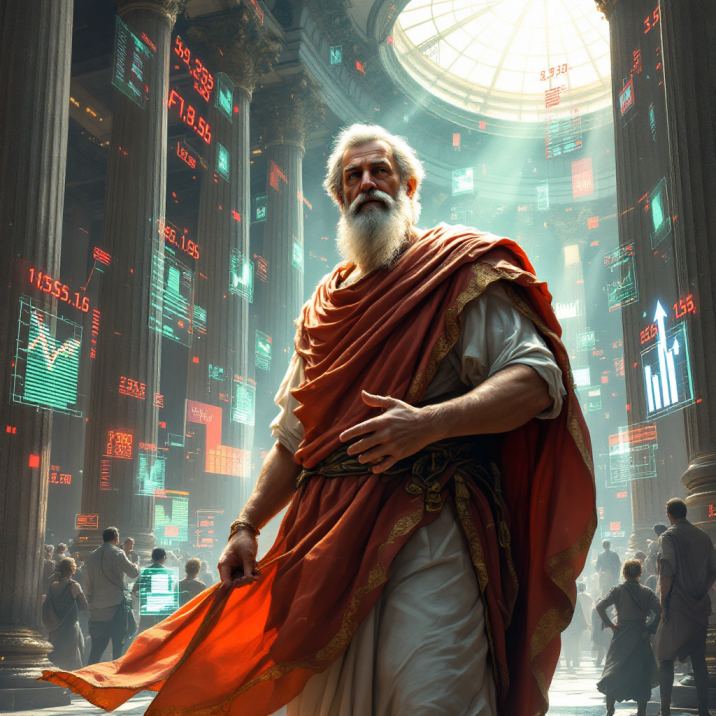
The Maverick’s Playbook: Mastering the Art of Market Mayhem!
Nov 15, 2024
Introduction: Opening Thunderbolt:
The stock market is not for the faint of heart. It’s a savage arena where fortunes are forged and shattered in the blink of an eye. Think of it as a gladiatorial battle, where the bulls and bears clash, driven by the primal forces of fear and greed. The weak are devoured in this arena, and only the bold survive. It’s time to embrace your inner warrior and step into the ring.
A Historical Wake-Up Call: Let’s travel back to the days of ancient Rome, where gladiators fought to the death in the Colosseum. The crowd, driven by bloodlust and excitement, cheered for their favourites, placing bets and hoping for a spectacular show. Now, fast-forward to today’s financial markets. We may not be betting on lives, but the stakes are just as high. The market is a modern-day Colosseum, a theatre of financial warfare where the crowd’s emotions drive the action.
Questioning Conventional Wisdom: Conventional wisdom tells us to play it safe, follow the herd, and trust in the market’s efficiency. But is that the path to success? Imagine if gladiators followed the crowd, mimicking the moves of their peers without independent thought. They’d be slaughtered. The same is true in the stock market. It would be best to challenge conventions, think for yourself, and embrace the unconventional to win.
Clash of the Titans: Genghis Khan vs. George Soros
What happens when you put Genghis Khan, the ultimate conqueror, in a room with George Soros, the billionaire investor known for breaking the Bank of England? An intellectual cage match ensues, blending ancient military strategy with modern market tactics. Khan, a master of swift and decisive action, advocates for aggressive, high-risk trades, much like his lightning-fast conquests. On the other hand, Soros champions the power of patience and strategic timing, using market trends to his advantage.
Ancient Wisdom Meets Modern Mind: Enter Plato, the Greek philosopher, who adds depth to their debate. He challenges Khan’s impulsive nature, urging him to seek underlying patterns and structures beyond the chaos of the market. Meanwhile, Khan’s relentless pursuit of victory resonates with Soros’ determination to exploit market vulnerabilities. It’s a battle of wits, where ancient wisdom and modern market savvy collide.
The Maverick’s Edge: The key takeaway in this clash of titans is clear: embrace the unconventional. Much like warfare, the market favours those who dare to be different. It’s not enough to follow the crowd; you must challenge it. Much like Khan and Soros, the maverick investor recognizes opportunities where others fear to tread. They harness the power of independent thought and strategic action, turning market chaos into their advantage.
The Psychology Pyramid Scheme:
The stock market is a massive psychological experiment, a pyramid scheme fueled by human nature. It preys on our deepest instincts, desires, and fears. Greed drives us to chase soaring stocks, while fear sends us running for the exits. This primal dance of emotions creates a volatility that defines the market’s unpredictable nature.
Dissecting Mass Delusions: Imagine the Dutch Tulip Mania of the 17th century, where a single tulip bulb could cost a fortune. It was a classic case of herd mentality gone wild. People bought into the frenzy, driven by the fear of missing out, only to be left holding worthless bulbs when the bubble burst. Like a skilled magician, the market manipulates our minds, blinding us to underlying realities.
Weapons of Mass Disruption: Behavioral finance is your sword and shield in this psychological battlefield. It reveals the biases and fallacies that drive market participants. Understanding these cognitive pitfalls can give you an edge from confirmation bias to herd mentality. By recognizing when the crowd is succumbing to these traps, you can make contrarian moves, buying when others are fearful and selling when they’re greedy.
The Adrenaline-Fueled Art of Chart Reading
Imagine yourself in a grand ballroom, a bustling hub of investors, each armed with their unique strategies and biases. The market is their dance floor, and chart patterns are the intricate steps they perform, driven by the underlying rhythm of human nature. These patterns reveal traders’ collective hopes, fears, and impulses like a secret code. You can anticipate their next steps by deciphering these movements, much like a chess grandmaster foreseeing their opponent’s moves.
Head and shoulders, double tops, cup and handle—these are more than just technical indicators. They are windows into the minds of market participants, offering insights into their motivations and sentiments. For instance, the head and shoulders pattern suggests a shift from optimism to scepticism, with a brief rebound in between. It’s like watching a crowd’s enthusiasm wane, only to be temporarily revived before ultimately fading away.
Technical analysis is your market telescope, allowing you to zoom in on traders’ intricate behaviours. It’s a tool to expose the market’s underlying biases and inefficiencies. By studying these patterns, you can spot trends before they become obvious to the crowd, giving you a strategic advantage. It’s about recognizing when the crowd is wrong when their emotions cloud their judgment, and then making bold contrarian moves.
Consider the double top pattern, often likened to a bell tolling at the market’s peak. It signals a potential reversal, a shift from bullish to bearish sentiment. By recognizing this pattern, Savvy investors may choose to short the stock or buy put options, betting on the downside. It’s a contrarian play against the initial trend but can pay off handsomely.
These patterns are not foolproof but provide valuable clues about market psychology. They help you identify areas of potential support and resistance where the crowd’s behaviour may change course. By understanding these dynamics, you can make more informed decisions, increasing your odds of success.
But remember, chart patterns are just one tool in your arsenal. They should be combined with other analytical approaches, such as fundamental analysis and risk management strategies. At its core, technical analysis is about recognizing and exploiting market inefficiencies, and chart patterns are a powerful way to do just that.
So, study the charts, decipher the patterns, and unlock the secrets of market psychology. It’s a game of strategic insight, where your ability to read the crowd can give you a decisive edge. But always remember, the market is dynamic, and the crowd’s behaviour is just one piece of the puzzle. Stay agile, stay curious, and never stop seeking a deeper understanding.
The Contrarian’s Cookbook: Where Rebellion Meets Riches
The aviation industry was in shambles when Warren Buffett bought American Airlines in 2016. While analysts screamed “doom,” Buffett saw an opportunity in chaos. The result? A 45% return before his exit. That’s contrarian investing in action—not just being different but strategically different.
The Three-Strike Strategy:
- Strike First: Identify oversold sectors where fear exceeds fundamentals
- Strike Hard: Deploy capital when blood is in the streets (2008 Financial Crisis: S&P 500 down 38%, contrarians who bought made 3x returns by 2011)
- Strike Smart: Use technical indicators to time entries (RSI below 30, high volume selling climaxes)
Battle-Tested Tactics:
– Buy “Dead” Companies: Netflix (2011) – Down 75%, now up 4,000%+
– Crisis Investing: Bitcoin (2018) – $3,000 to $69,000
– Sector Rotation: Energy stocks (2020) – XLE ETF up 180% post-COVID crash
Remember: The crowd isn’t always wrong, but the biggest profits come from being right when most are bad. Your edge? Emotional discipline when others panic, deep research when others follow headlines, and patience when others chase quick wins.
The market rewards the bold, not the comfortable. Choose your battles, trust your analysis, and strike when others retreat. That’s how legends are made.
The Grand Finale:
The Mind-Bending Perspective Shift: As you step back and reflect on this journey, it’s time to embrace a new reality. The stock market is not just a place to invest; it reflects human nature in all its glory and madness. It’s a chaotic dance of greed and fear, hope and despair. But within this chaos lies order, patterns, and the potential for profound financial success.
The Market’s True Nature: The market is a living, breathing, ever-evolving organism. It’s a complex system, influenced by countless variables, from economic policies to breaking news. Understanding this dynamic nature is key to your success. You must adapt, evolve, and constantly challenge your assumptions. The market is a relentless teacher, rewarding those who embrace its lessons and punishing those who ignore them.
Your Financial Legacy: You now possess the tools of the maverick investor: a rare blend of ancient wisdom and modern market savvy. You’ve learned to recognize behavioural biases, exploit market inefficiencies, and make bold, calculated moves. But remember, the journey doesn’t end here. The market is a lifelong adventure, a relentless pursuit of knowledge and profit. So, embrace the unknown, challenge conventions, and leave your mark on the financial world. Your financial legacy awaits.
Mindful Escapes: Nurturing Intellect and Soul

Yuan vs. Yen vs. the World: The Race to Global Dominance or?

Momentum investing strategy: can it really give you an edge?

Redefining Success Through the Wolf Mentality Meaning

How To Deal with Social Anxiety: Unveiling Crowd Phobia

Stock market crash coming 2025: real threat or exaggerated worry?

Stock market retracement: is it a momentary dip or a big warning?

Best Chinese Stocks: Buy, Hold Or Fold

Is psychological edge play the key to conquering market panic?

Synthetic Long Put Position: Minimize Risk, Maximize Profit

Norse Pagan Religion, from Prayers to Viking-Style Warriors

Black Monday 1987: Turning Crashes into Opportunities

The Normalcy Bias Meaning: A Crucial Concept for Today’s Investors

Green investing strategy: Can it transform your financial future?

October 1987 Stock Market Crash: Victory for the Wise, Pain for the Fools



